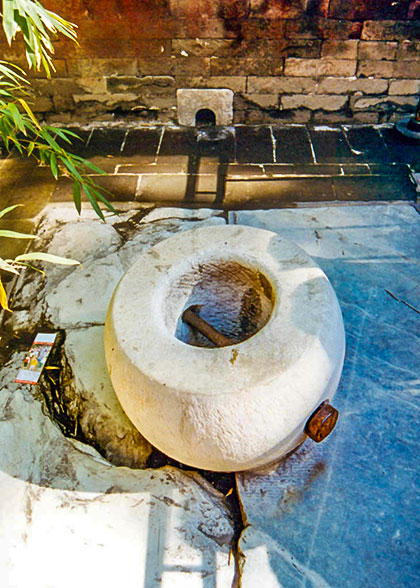Qianlong Garden & Pavilion of Pleasant Sounds
-- Northwest and Northeast of Palace of Tranquil Longevity Area
The northwest part of the Palace of Tranquil Longevity Area/Complex is the Qianlong Garden. The northeast part consists of buildings such as the Dressing House (Banxilou), the Pavilion of Pleasant Sounds (Changyinge), the Hall for Viewing Opera (Yueshilou). Generally speaking, these two parts served as the recreational and entertainment places for the imperial household. The following is a detailed introduction to the northwest and northeast parts.
Northwest Part of Palace - Qianlong Garden
It is located at the northwest part of the Palace of Tranquil Longevity Area, also called Garden of Palace of Tranquil Longevity (Ningshougong Garden). It was designed to include four scenes in four areas.
 |
| Pavilion of Expecting Good Omen |
Pavilion of Expecting Good Omen (Fuwangge)
Well of Concubine Zhen (Zhenfeijing)
 |
| Well of Concubine Zhen |
In the northern end of the Qianlong Garden, beside the Pavilion of Expecting Good Omen, is the Well of Concubine Zhen. When it comes to this well, a story unfolds. In 1887, the thirteenth year in the reign of the Qing Emperor Guangxu (1877-1908), Guangxu selected Dowager Cixi's niece as the empress under the threat of this powerful woman. Later, he fell in love with the kind and smart lady, Concubine Zhen who also supported his political reform. However, Dowager Cixi hated her a lot. In year 1898, with tricky plans, Dowager Cixi made the political reform a failure so that she took power again. Since then, Cixi confined Concubine Zhen in the small yard behind Jingqi Chamber and stopped her from seeing Guangxu.
In 1900, the Eight Allied Army attacked Beijing. Dowager Cixi did not forget to lay murderous hands on Concubine Zhen before she fled to Xi'an with Emperor Guangxu who was under house arrest before. She ordered the deputy supervisor of the Imperial Palace to tell Concubine Zhen to jump into a well to commit suicide under the excuse of "avoiding the defilement of the foreigners". However, Concubine Zhen did not buy it and abused before Cixi. Full of rage, Cixi commanded some eunuchs to push her into the well. They took her to the Eight Treasures Glided Well (Babaoliulijin) but failed to throw her into the well as she held the marble column tightly. He then moved her to a bald well beside Jingqi Chamber and pushed her down to the well with full strength. Before leaving, he pressed a round stone on the well.
After Concubine Zhen was killed, her body remained in the well for more than a year. The corpse wouldn't be dragged up until concubine Jin, her elder sister, came to beg others for help the next year. North of the well, Concubine Jin built a condolence hall for her. In later days, people call the well Zhenfeijing to commemorate Concubine Zhen.
Northeast Part of Palace
The northeast part of the Palace of Tranquil Longevity Area/Complex includes structures such as the Theater Pavilion (Banxilou), the Pavilion of Pleasant Sounds (Changyinge), the Hall for Viewing Opera (Yueshilou), as well as the Palace of Scenery and Happiness (Jingfugong).
Pavilion of Pleasant Sounds (Changyinge)
 |
| Pavilion of Pleasant Sounds |
Lying to the east of the Hall of Spiritual Cultivation, it is the biggest theater inside the Forbidden City. Together with Deheyuan Theater in the Garden of Virtue and Harmony of Summer Palace and Qingyin Pavilion in the Chengde Imperial Summer Resort, they are considered the three big theaters of the Qing Dynasty (1616-1911). The construction started from 1772 to 1776 and it is maintained in 1802 and 1891. The present look is what it was after restoration during the reign of Jiaqing. With a 1.2 meters (3.94 ft.) high stone base, the total height of it is 20.71 meters (67.95 ft.) and the total area is 685.94 square meters. All together it has three storeys, the upper one "Stage of Happiness (Fulou)", the middle one "Stage of Wealth (Lulou)" and the lower one "Stage of Longevity (Shoulou)".
In ancient China, theatergoing was the main entertainment activity in the Imperial Palace. Operas were staged on all kinds of festivals, such as the lunar New Year, the Spring Begins, the Dragon-Boat Festival, the Double Seventh Festival (the seventh day of the lunar July), the Mid-Autumn Day, the Double Ninth Festival, the Winter Solstice, and the eve of Spring Festival as well as other important occasions, such as the emperor's accession to the throne, and the birthdays of emperors and empresses. It is documented that at the end of the Qing Dynasty, when Dowager Cixi was in power, she went to enjoy operas here whenever there was a festival. On her fiftieth birthday in 1884, the costumes and properties of the celebration opera cost as much as 110,000 taels of silvers.
Hall for Viewing Opera (Yueshilou)
To the north of the Pavilion of Pleasant Sounds stands a two-storey building called the Hall for Viewing Opera (Yueshilou). It was the place for emperors and empresses and other members of the imperial family to watch performances. Court ladies and ministers could watch performances at the corridors under the side buildings on the west and east.
Exhibition "Opera at the Qing Court" is open all year round in the Hall for Viewing Opera.
![]() Next:
Next:
Go west back to the central axis, visit the Imperial Garden (Yuhuayuan), or exit the Forbidden City through the Gate of Divine Prowess (Shenwumen).![]() Further Reading:
Further Reading:
How to visit the Forbidden City
Gutters on the Wall of Palace of Tranquil Longevity